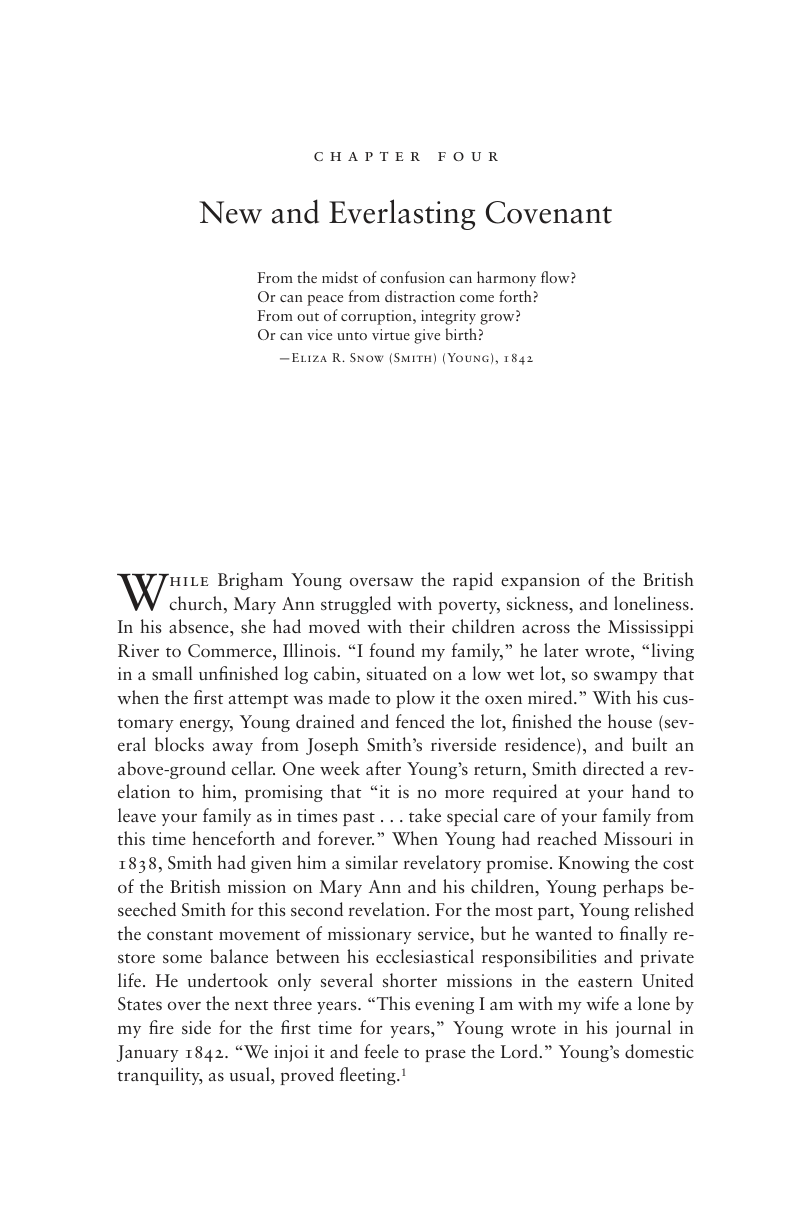John Turner writers on the origins of plural marriage in Nauvoo and discusses Brigham Young's participation.
- Type
- Book
- Source
- John Turner Non-LDS
- Hearsay
- DirectSecondary
- Reference
John G. Turner, Brigham Young: Pioneer Prophet (Cambridge, MA: Harvard University Press, 2012), 80–109
- Scribe/Publisher
- Harvard University Press
- People
- John Turner
- Audience
- Reading Public
- Transcription
The husbands and wives Smith welded together for eternity, however, were often not legally married, at least not to each other. The early history of Mormon polygamy remains shrouded by unreliable, retrospective testimony, usually either from bitter enemies of the church or from staunch defenders of plural marriage’s divine origins. As was logical for a prophet committed to the “restitution of all things,” from the earliest days of his church Smith considered the marriage practices of the Hebrew patriarchs. In Kirtland, Smith engaged in his first well-documented nonmonogamous relationship, with a servant girl named Fanny Alger. Smith’s defenders, and some of his detractors, later described the relationship with Alger as the prophet’s first plural marriage. The relationship angered Smith’s wife Emma; it also produced allegations of adultery from high-ranking associate Oliver Cowdery, who termed it a “dirty, nasty, filthy affair.” By 1836, Alger had exited the relationship; she soon married a non-Mormon. Around the time that Brigham Young and his fellow apostles returned from England in the spring of 1841, Smith was “sealed” to Louisa Beaman, daughter of an old family friend. Joseph Bates Noble, Beaman’s brother-in-law and the officiator at the ceremony, recalled that Beaman disguised herself in a man’s coat and hat to avoid attracting attention.
. . .
At some point in early 1842, Smith told him to “go & get another wife.” Young recalled that the instruction came in the form of a “command,” not a choice. Still, he hesitated. “I felt as if the grave was better for me,” he later explained. After discussing the matter with Smith, though, the apostle quickly moved from apprehension to exhilaration. “I was filled with the Holy Ghost,” he recalled, “that my wife and Brother Kimball’s wife would upbraid me for lightness in those days. I could jump up and hollow [holler], my blood clear as India Rum.” Young was “ready to go ahead.” Like many others, he followed where his prophet led. No one would marry more women in Nauvoo than Brigham Young. The exact dates of several early polygamous sealings are uncertain, but Young was one of the first men besides Smith to attempt to live out the principle of plural marriage.
. . .
Undeterred by Brotherton’s rejection and the unfolding scandal, on June 14 Young married twenty-year-old Lucy Ann Decker. Smith officiated at the ceremony. At the time she became Young’s first plural wife, Lucy Ann Decker was already the wife of William Seeley, whom she had married at around the age of fourteen. Young family lore identifies Seeley as an alcoholic who had abandoned his family, but he was at least still in Nauvoo. Young’s account book reveals several transactions with William Seeley in July 1842, during which he paid him a total of $19. Several decades later, Lucy recalled that Joseph Smith had performed the ceremony, with Willard Richards present as the only witness. Presumably her father, Isaac Decker, was aware of the ceremony. Smith married into families with which he had close friendships, and the Young family had known Isaac Decker for many years. Brigham’s marriage to Lucy thus strengthened a preexisting bond between the two families.
. . .
That resolute devotion prompted Young to marry additional wives. When Young departed Boston in late September 1843, forty-year-old Augusta Adams Cobb joined his party. Married to the prosperous Henry Cobb, Augusta and Henry’s sister Elizabeth had both joined the church in 1832, baptized by the prophet’s brother Samuel. Henry rejected the missionaries’ message and never joined the church. When Augusta departed Boston with Brigham Young eleven years later, she left behind Henry and most of her children, taking with her only her daughter Charlotte and an infant son. In early October, Young recorded that Augusta’s “Babe Died of the consumpsion” in Cincinnati. Augusta “had hir babe put in a tin coffin tooke it with us.” A few weeks later, the Nauvoo sexton made an official record of the consumptive death of five-month-old “Brigham Y. Cobb.” The choice of names suggests that Young had made a strong impression on Augusta during his northeastern missionary trips.48
- Citations in Mormonr Qnas
The B. H. Roberts Foundation is not owned by, operated by, or affiliated with the Church of Jesus Christ of Latter-day Saints.

